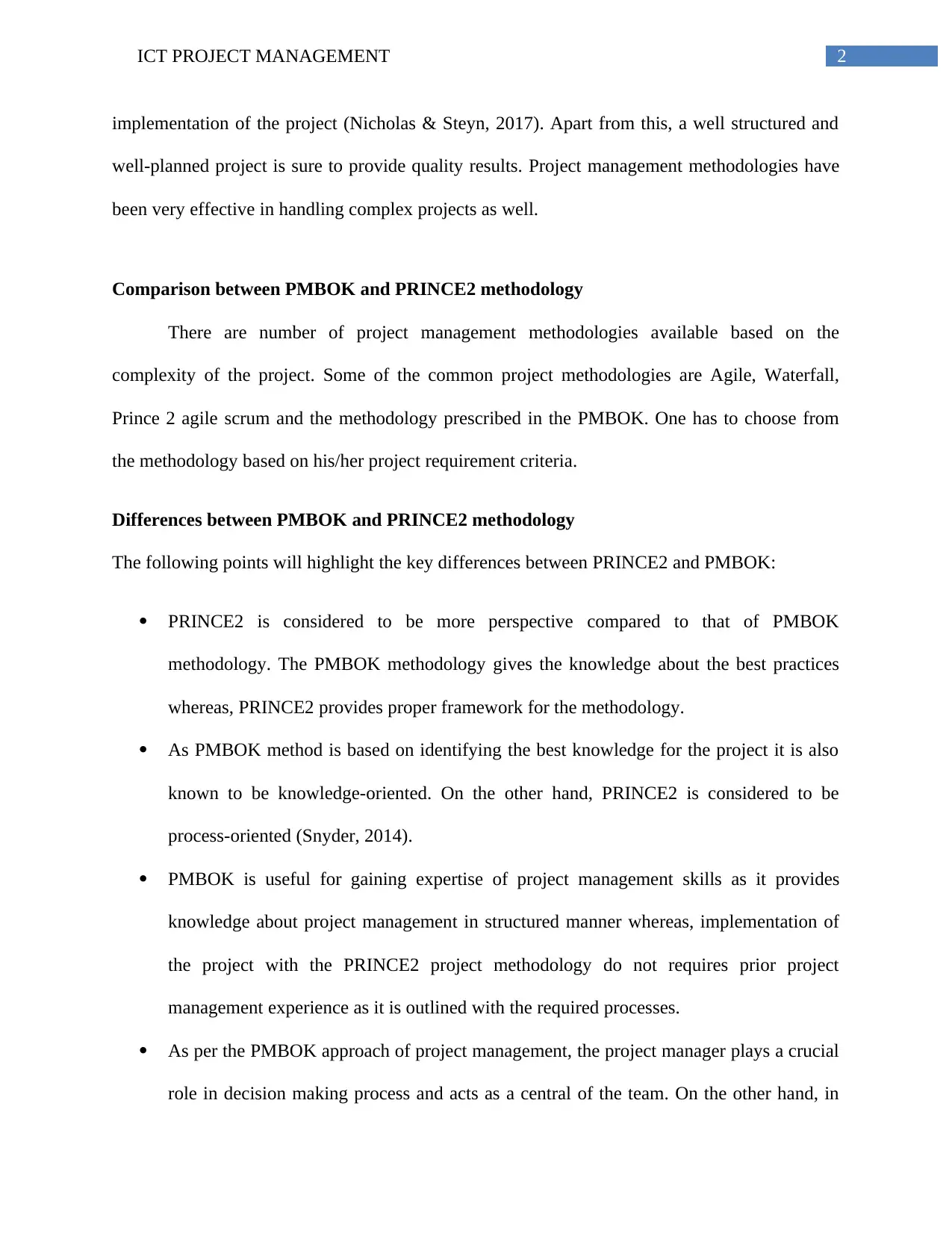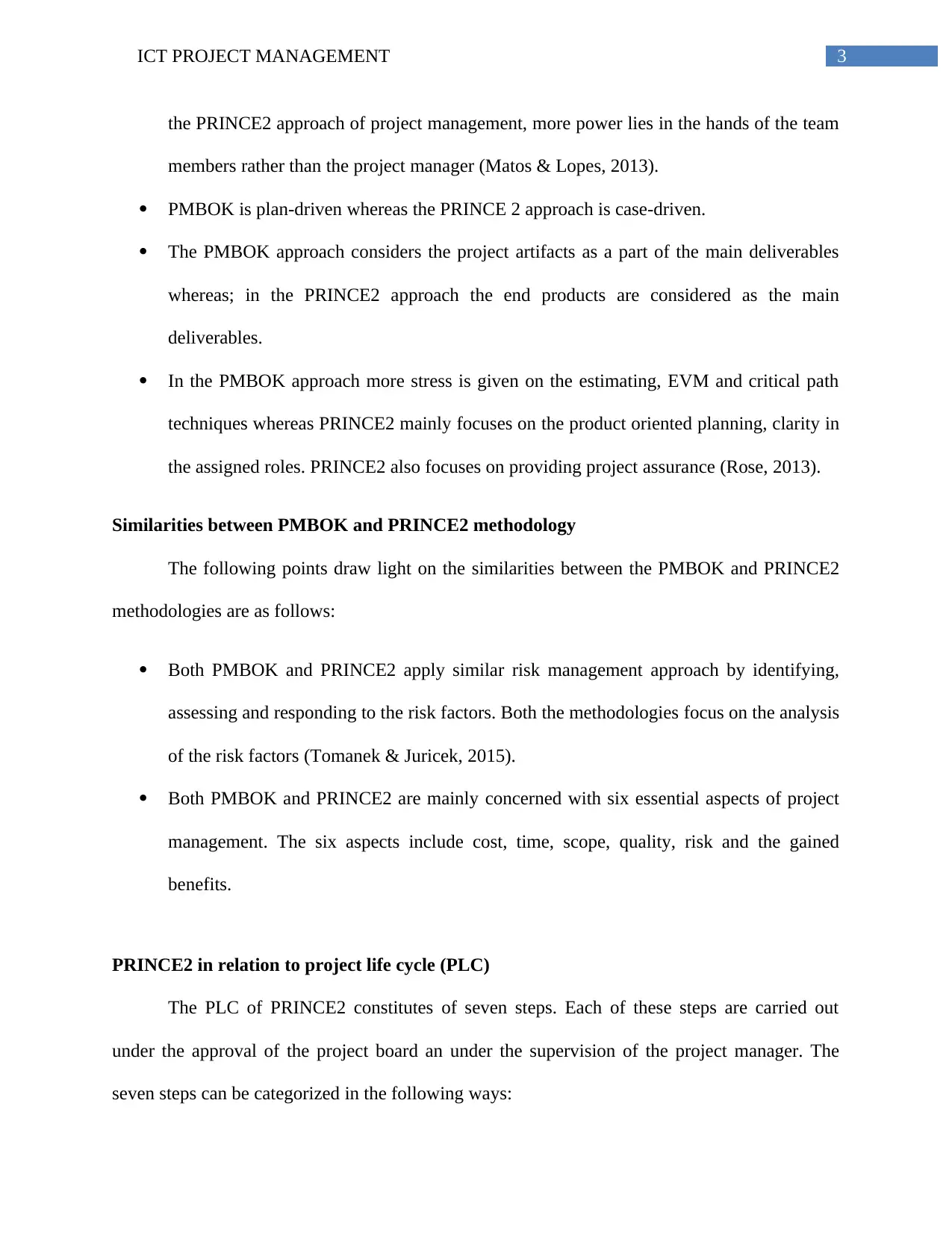ICT Project Management: PMBOK and PRINCE2 Comparison Report
VerifiedAdded on 2021/04/24
|6
|1438
|25
Report
AI Summary
This report provides a comprehensive overview of ICT project management, beginning with a definition of project methodology and its importance in ensuring systematic project delivery and risk mitigation. It delves into a detailed comparison between two prominent methodologies: PMBOK and PRINCE2, highlighting their key differences in terms of perspective, knowledge orientation, process orientation, decision-making approach, and project artifacts. The report also explores the similarities between the two methodologies, particularly in their approach to risk management and their focus on essential aspects of project management, such as cost, time, scope, quality, and benefits. Furthermore, the report examines the PRINCE2 project life cycle, outlining its seven stages, including project initiation, planning, control, and closure, and how these stages are managed to ensure project success. The report concludes by referencing the sources used to support the findings, providing a useful resource for students studying ICT project management.

Running head: ICT PROJECT MANAGEMENT
ICT PROJECT MANAGEMENT
Name of Student
Name of University
Author note
ICT PROJECT MANAGEMENT
Name of Student
Name of University
Author note
Paraphrase This Document
Need a fresh take? Get an instant paraphrase of this document with our AI Paraphraser

1ICT PROJECT MANAGEMENT
Definition of project methodology
The term “project methodology” was first coined in the early 1960s. Project methodology
can be defined as the set of measures that is undertaken by the various business organizations for
simplifying and organizing their business proceedings. In the present date, this term is further
modified with newer definition. Newer elements and functions are added to this term. A number
of definitions have been given by various scholars. As per the scholars, project methodology is
the combination of set of specified rules, practices and processes which helps to identify the best
plan and helps in the development of the project throughout the implementation process until the
project is successfully completed (Parker et al., 2013). Other authors states that the project
methodology is scientific, disciplined and systematic method for the successful execution of the
respective projects. In other words, “project methodology” can be described as the model,
applied by the project manager for the design and implementation to meet the concerned project
objectives (Ralf Müller, 2014). There are number of project management methodologies
available based on the project requirements.
Importance of project methodologies in project management
Project methodologies ensure comprehensive and systematic delivery of projects.
Utilization of project methodologies helps in making the project less susceptible to the risks that
the project might encounter. The methodologies also enable the organization to suspect the risks
as well as difficulties that the project might get prone to and in the process it also helps in finding
the alternatives to minimize the chances of the risk factors. Project methodology also plays an
important role in the operational level. It is considered as the key factor with the help of which
the project manager assists the project team to opt for appropriate measure for the successful
Definition of project methodology
The term “project methodology” was first coined in the early 1960s. Project methodology
can be defined as the set of measures that is undertaken by the various business organizations for
simplifying and organizing their business proceedings. In the present date, this term is further
modified with newer definition. Newer elements and functions are added to this term. A number
of definitions have been given by various scholars. As per the scholars, project methodology is
the combination of set of specified rules, practices and processes which helps to identify the best
plan and helps in the development of the project throughout the implementation process until the
project is successfully completed (Parker et al., 2013). Other authors states that the project
methodology is scientific, disciplined and systematic method for the successful execution of the
respective projects. In other words, “project methodology” can be described as the model,
applied by the project manager for the design and implementation to meet the concerned project
objectives (Ralf Müller, 2014). There are number of project management methodologies
available based on the project requirements.
Importance of project methodologies in project management
Project methodologies ensure comprehensive and systematic delivery of projects.
Utilization of project methodologies helps in making the project less susceptible to the risks that
the project might encounter. The methodologies also enable the organization to suspect the risks
as well as difficulties that the project might get prone to and in the process it also helps in finding
the alternatives to minimize the chances of the risk factors. Project methodology also plays an
important role in the operational level. It is considered as the key factor with the help of which
the project manager assists the project team to opt for appropriate measure for the successful

2ICT PROJECT MANAGEMENT
implementation of the project (Nicholas & Steyn, 2017). Apart from this, a well structured and
well-planned project is sure to provide quality results. Project management methodologies have
been very effective in handling complex projects as well.
Comparison between PMBOK and PRINCE2 methodology
There are number of project management methodologies available based on the
complexity of the project. Some of the common project methodologies are Agile, Waterfall,
Prince 2 agile scrum and the methodology prescribed in the PMBOK. One has to choose from
the methodology based on his/her project requirement criteria.
Differences between PMBOK and PRINCE2 methodology
The following points will highlight the key differences between PRINCE2 and PMBOK:
PRINCE2 is considered to be more perspective compared to that of PMBOK
methodology. The PMBOK methodology gives the knowledge about the best practices
whereas, PRINCE2 provides proper framework for the methodology.
As PMBOK method is based on identifying the best knowledge for the project it is also
known to be knowledge-oriented. On the other hand, PRINCE2 is considered to be
process-oriented (Snyder, 2014).
PMBOK is useful for gaining expertise of project management skills as it provides
knowledge about project management in structured manner whereas, implementation of
the project with the PRINCE2 project methodology do not requires prior project
management experience as it is outlined with the required processes.
As per the PMBOK approach of project management, the project manager plays a crucial
role in decision making process and acts as a central of the team. On the other hand, in
implementation of the project (Nicholas & Steyn, 2017). Apart from this, a well structured and
well-planned project is sure to provide quality results. Project management methodologies have
been very effective in handling complex projects as well.
Comparison between PMBOK and PRINCE2 methodology
There are number of project management methodologies available based on the
complexity of the project. Some of the common project methodologies are Agile, Waterfall,
Prince 2 agile scrum and the methodology prescribed in the PMBOK. One has to choose from
the methodology based on his/her project requirement criteria.
Differences between PMBOK and PRINCE2 methodology
The following points will highlight the key differences between PRINCE2 and PMBOK:
PRINCE2 is considered to be more perspective compared to that of PMBOK
methodology. The PMBOK methodology gives the knowledge about the best practices
whereas, PRINCE2 provides proper framework for the methodology.
As PMBOK method is based on identifying the best knowledge for the project it is also
known to be knowledge-oriented. On the other hand, PRINCE2 is considered to be
process-oriented (Snyder, 2014).
PMBOK is useful for gaining expertise of project management skills as it provides
knowledge about project management in structured manner whereas, implementation of
the project with the PRINCE2 project methodology do not requires prior project
management experience as it is outlined with the required processes.
As per the PMBOK approach of project management, the project manager plays a crucial
role in decision making process and acts as a central of the team. On the other hand, in
⊘ This is a preview!⊘
Do you want full access?
Subscribe today to unlock all pages.

Trusted by 1+ million students worldwide

3ICT PROJECT MANAGEMENT
the PRINCE2 approach of project management, more power lies in the hands of the team
members rather than the project manager (Matos & Lopes, 2013).
PMBOK is plan-driven whereas the PRINCE 2 approach is case-driven.
The PMBOK approach considers the project artifacts as a part of the main deliverables
whereas; in the PRINCE2 approach the end products are considered as the main
deliverables.
In the PMBOK approach more stress is given on the estimating, EVM and critical path
techniques whereas PRINCE2 mainly focuses on the product oriented planning, clarity in
the assigned roles. PRINCE2 also focuses on providing project assurance (Rose, 2013).
Similarities between PMBOK and PRINCE2 methodology
The following points draw light on the similarities between the PMBOK and PRINCE2
methodologies are as follows:
Both PMBOK and PRINCE2 apply similar risk management approach by identifying,
assessing and responding to the risk factors. Both the methodologies focus on the analysis
of the risk factors (Tomanek & Juricek, 2015).
Both PMBOK and PRINCE2 are mainly concerned with six essential aspects of project
management. The six aspects include cost, time, scope, quality, risk and the gained
benefits.
PRINCE2 in relation to project life cycle (PLC)
The PLC of PRINCE2 constitutes of seven steps. Each of these steps are carried out
under the approval of the project board an under the supervision of the project manager. The
seven steps can be categorized in the following ways:
the PRINCE2 approach of project management, more power lies in the hands of the team
members rather than the project manager (Matos & Lopes, 2013).
PMBOK is plan-driven whereas the PRINCE 2 approach is case-driven.
The PMBOK approach considers the project artifacts as a part of the main deliverables
whereas; in the PRINCE2 approach the end products are considered as the main
deliverables.
In the PMBOK approach more stress is given on the estimating, EVM and critical path
techniques whereas PRINCE2 mainly focuses on the product oriented planning, clarity in
the assigned roles. PRINCE2 also focuses on providing project assurance (Rose, 2013).
Similarities between PMBOK and PRINCE2 methodology
The following points draw light on the similarities between the PMBOK and PRINCE2
methodologies are as follows:
Both PMBOK and PRINCE2 apply similar risk management approach by identifying,
assessing and responding to the risk factors. Both the methodologies focus on the analysis
of the risk factors (Tomanek & Juricek, 2015).
Both PMBOK and PRINCE2 are mainly concerned with six essential aspects of project
management. The six aspects include cost, time, scope, quality, risk and the gained
benefits.
PRINCE2 in relation to project life cycle (PLC)
The PLC of PRINCE2 constitutes of seven steps. Each of these steps are carried out
under the approval of the project board an under the supervision of the project manager. The
seven steps can be categorized in the following ways:
Paraphrase This Document
Need a fresh take? Get an instant paraphrase of this document with our AI Paraphraser

4ICT PROJECT MANAGEMENT
Starting the project- This stage involves explaining the purpose that the project serves. In
this stage the initial planning of the project is done such as how the project can be
executed and the resources required for the project.
Project initiation- In this stage the project requirements are addressed. The project lead
sets the target for time, cost, scope and quality for the project.
Project direction- This step involves the overall process of project planning. Activities
such as project initiation, setting the boundaries following the direction and project
closure are included in this step.
Project control- This step includes dividing the project activities into number of
manageable activities. As per this step, the project manager is required to report the work
progress and address the problems associated with the project plan and the team manager
is required to coordinate the team work (Turner, 2016).
Managing the delivery- This step mainly consist of three major activities such as
accepting, executing and delivering of the work packages.
Stage boundaries management- Each of the stages of project planning is reviewed by the
board members and the project managers. The continuity of the project is decided by the
board members. This stage mainly comprises of the activities of planning the consecutive
stages, updating the project as well as the business plan and presenting the execution plan
(Jamali & Oveisi, 2016).
Project closure- This stage includes project decommission, analyzing the project benefits,
evaluation of the reviews, free up the unused resources and final handover of the products
to the end users.
Starting the project- This stage involves explaining the purpose that the project serves. In
this stage the initial planning of the project is done such as how the project can be
executed and the resources required for the project.
Project initiation- In this stage the project requirements are addressed. The project lead
sets the target for time, cost, scope and quality for the project.
Project direction- This step involves the overall process of project planning. Activities
such as project initiation, setting the boundaries following the direction and project
closure are included in this step.
Project control- This step includes dividing the project activities into number of
manageable activities. As per this step, the project manager is required to report the work
progress and address the problems associated with the project plan and the team manager
is required to coordinate the team work (Turner, 2016).
Managing the delivery- This step mainly consist of three major activities such as
accepting, executing and delivering of the work packages.
Stage boundaries management- Each of the stages of project planning is reviewed by the
board members and the project managers. The continuity of the project is decided by the
board members. This stage mainly comprises of the activities of planning the consecutive
stages, updating the project as well as the business plan and presenting the execution plan
(Jamali & Oveisi, 2016).
Project closure- This stage includes project decommission, analyzing the project benefits,
evaluation of the reviews, free up the unused resources and final handover of the products
to the end users.

5ICT PROJECT MANAGEMENT
References
Jamali, G., & Oveisi, M. (2016). A Study on Project Management Based on PMBOK and
PRINCE2. Modern Applied Science, 10(6), 142.
Matos, S., & Lopes, E. (2013). Prince2 or PMBOK–a question of choice. Procedia
Technology, 9, 787-794.
Nicholas, J. M., & Steyn, H. (2017). Project management for engineering, business and
technology. Taylor & Francis.
Parker, D., Charlton, J., Ribeiro, A., & D. Pathak, R. (2013). Integration of project-based
management and change management: Intervention methodology. International Journal
of Productivity and Performance Management, 62(5), 534-544.
Ralf Müller, D. B. A. (2014). The impact of project methodologies on project success in different
contexts.
Rose, K. H. (2013). A Guide to the Project Management Body of Knowledge (PMBOK® Guide)
—Fifth Edition. Project management journal, 44(3).
Snyder, C. S. (2014). A guide to the project management body of knowledge: PMBOK (®)
guide. Project Management Institute: Newtown Square, PA, USA.
Tomanek, M., & Juricek, J. (2015). Project risk management model based on PRINCE2 and
SCRUM frameworks. arXiv preprint arXiv:1502.03595.
Turner, R. (2016). Gower handbook of project management. Routledge.
References
Jamali, G., & Oveisi, M. (2016). A Study on Project Management Based on PMBOK and
PRINCE2. Modern Applied Science, 10(6), 142.
Matos, S., & Lopes, E. (2013). Prince2 or PMBOK–a question of choice. Procedia
Technology, 9, 787-794.
Nicholas, J. M., & Steyn, H. (2017). Project management for engineering, business and
technology. Taylor & Francis.
Parker, D., Charlton, J., Ribeiro, A., & D. Pathak, R. (2013). Integration of project-based
management and change management: Intervention methodology. International Journal
of Productivity and Performance Management, 62(5), 534-544.
Ralf Müller, D. B. A. (2014). The impact of project methodologies on project success in different
contexts.
Rose, K. H. (2013). A Guide to the Project Management Body of Knowledge (PMBOK® Guide)
—Fifth Edition. Project management journal, 44(3).
Snyder, C. S. (2014). A guide to the project management body of knowledge: PMBOK (®)
guide. Project Management Institute: Newtown Square, PA, USA.
Tomanek, M., & Juricek, J. (2015). Project risk management model based on PRINCE2 and
SCRUM frameworks. arXiv preprint arXiv:1502.03595.
Turner, R. (2016). Gower handbook of project management. Routledge.
⊘ This is a preview!⊘
Do you want full access?
Subscribe today to unlock all pages.

Trusted by 1+ million students worldwide
1 out of 6
Related Documents
Your All-in-One AI-Powered Toolkit for Academic Success.
+13062052269
info@desklib.com
Available 24*7 on WhatsApp / Email
![[object Object]](/_next/static/media/star-bottom.7253800d.svg)
Unlock your academic potential
Copyright © 2020–2025 A2Z Services. All Rights Reserved. Developed and managed by ZUCOL.




